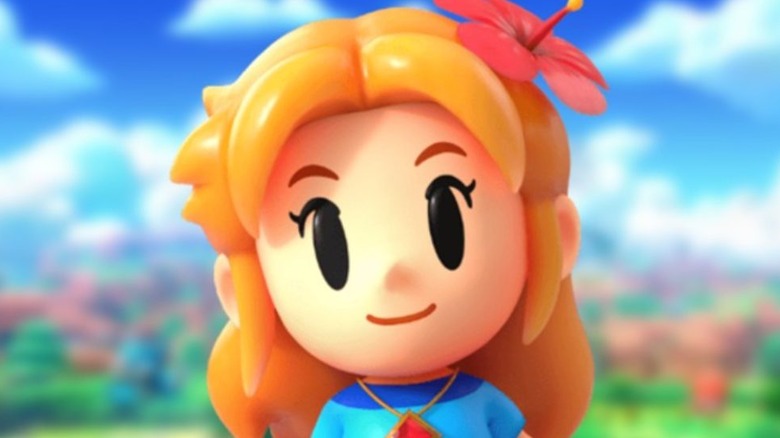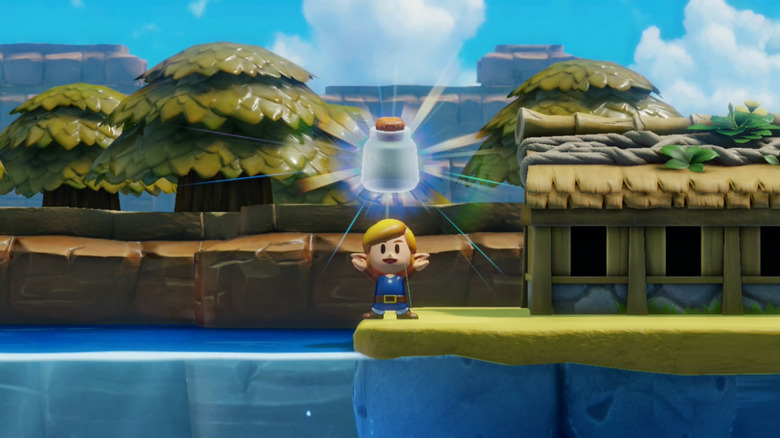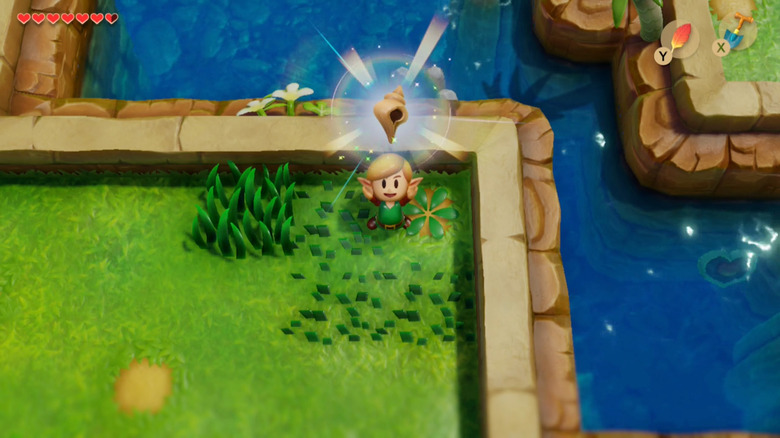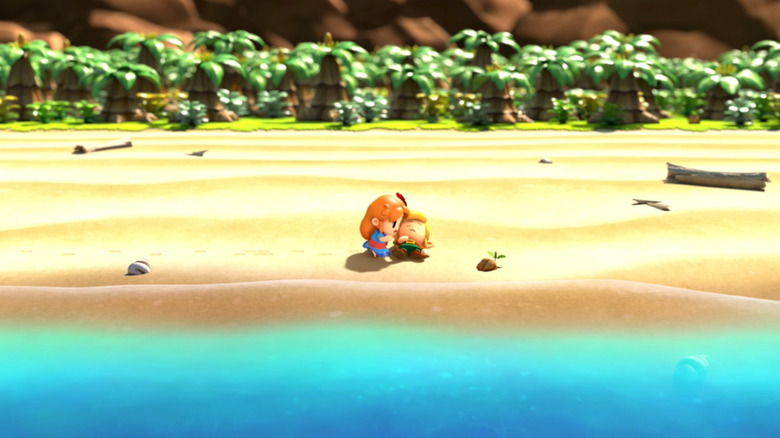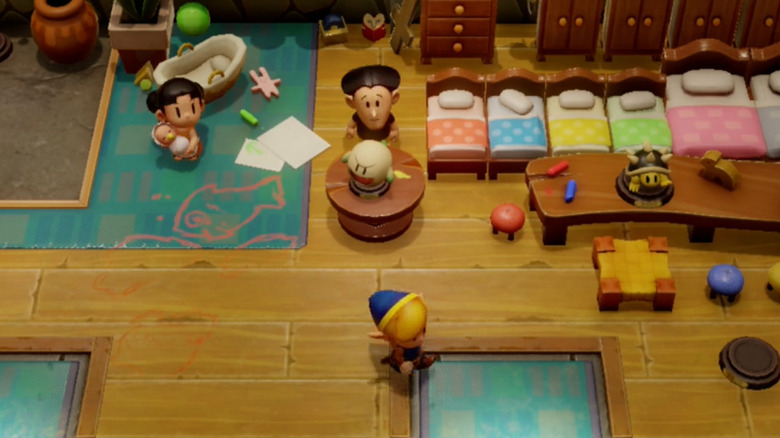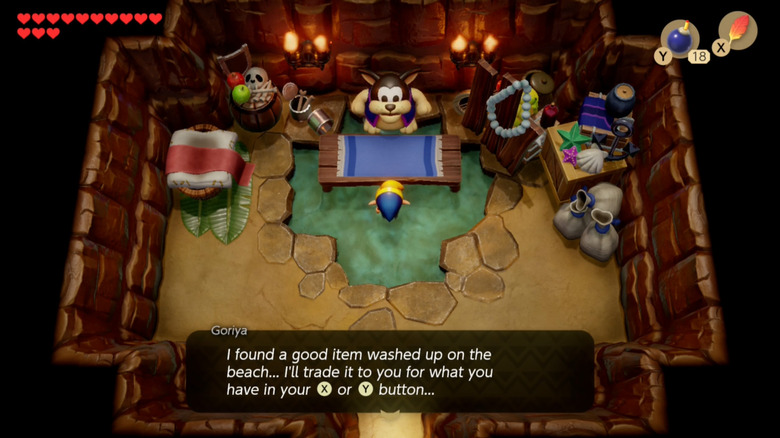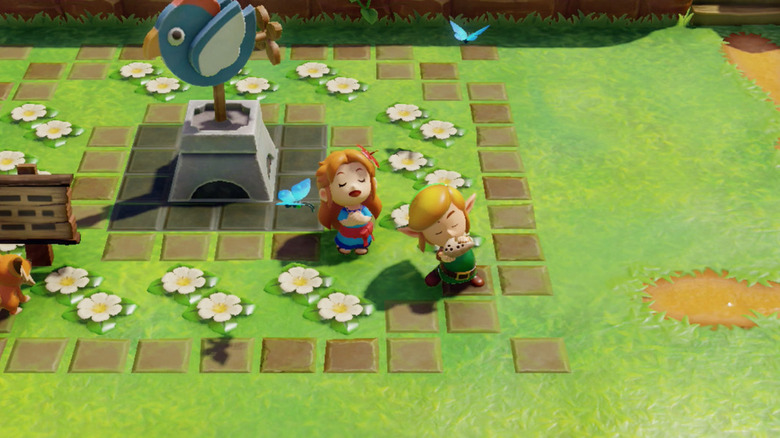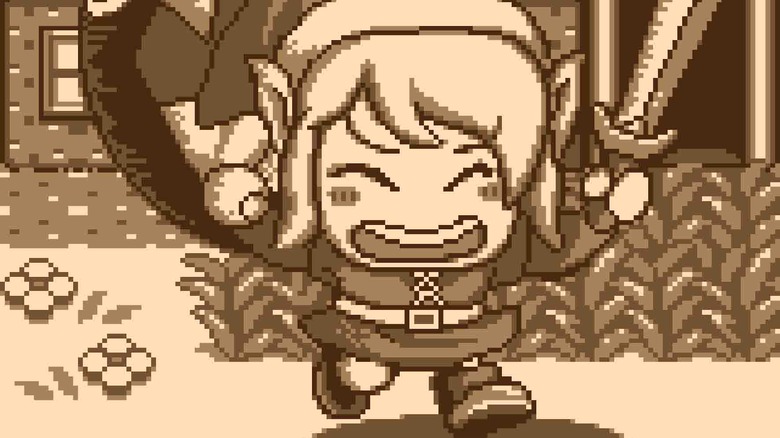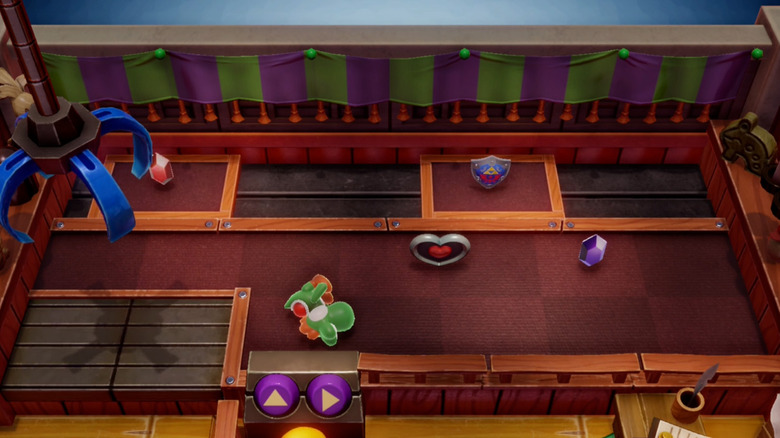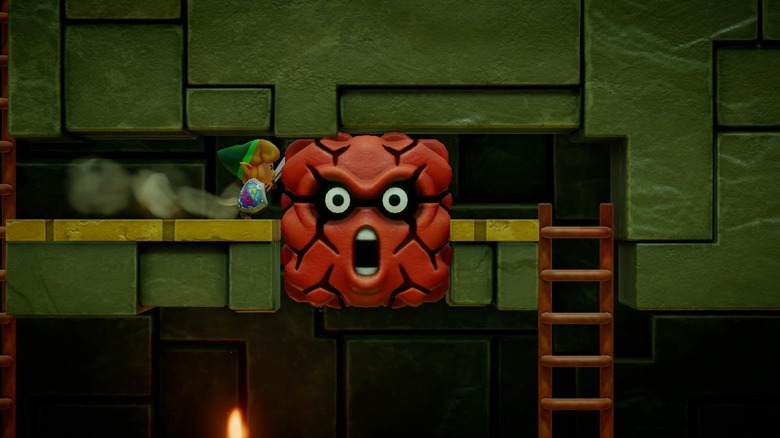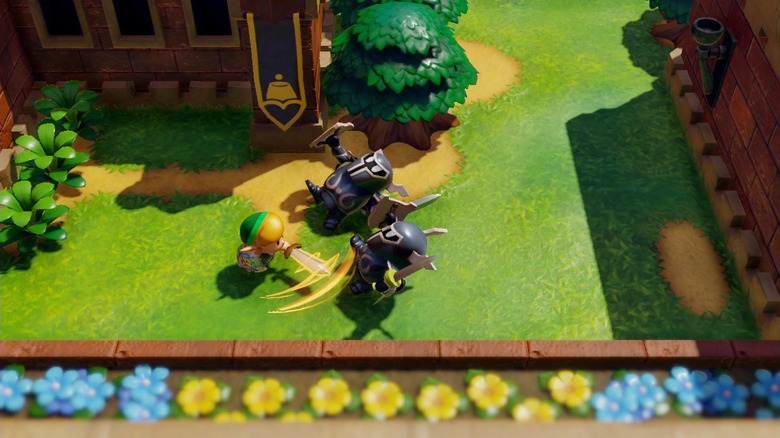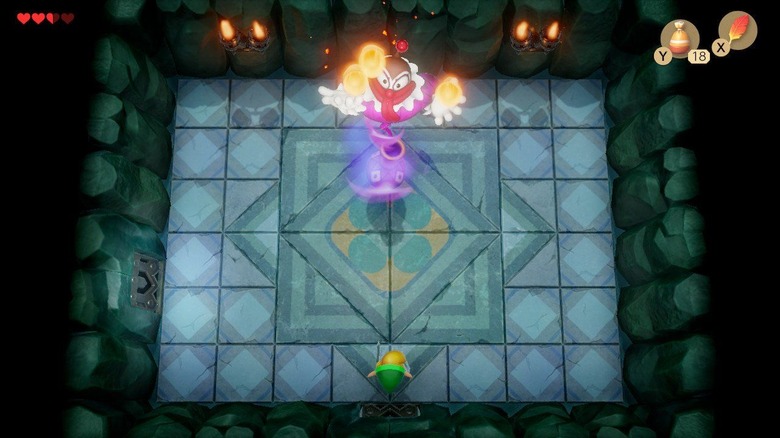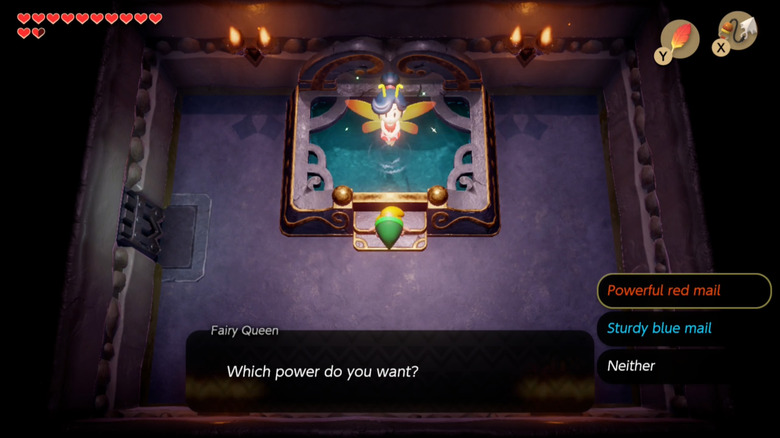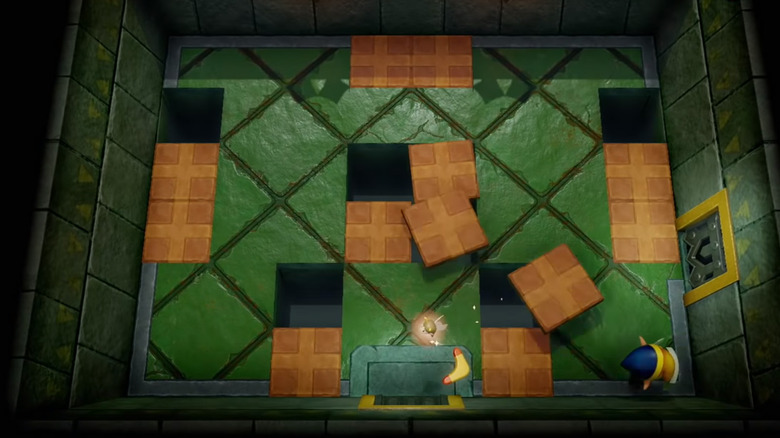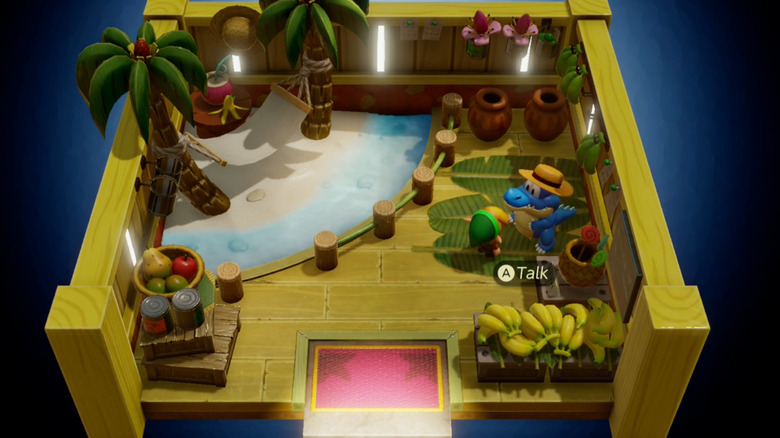Small Changes Only True Fans Noticed In The Link's Awakening Remake
The Legend of Zelda: Link's Awakening on the Nintendo Switch is remarkably faithful to the Game Boy game (and its revised edition, the Game Boy Color's Link's Awakening DX) that started it all, but it's not exactly the same. Oh, it's close. Set aside the new, ultra-adorable art style and the brand new Chamber Dungeon feature, and you're left with the same game that came out in '93 — almost.
A new line of dialogue here. A new secret there. A fresh feature or small quality-of-life improvement that's so well integrated with the rest of the game that you don't even remember that it wasn't part of the game you played in the early '90s. You need to know Link's Awakening very well to spot the differences between the original and the HD remake, but they're there. If you haven't played Link's first portable adventure for 26 years — or if you've never played it at all — don't fret. We'll help you find them.
For the first time ever, catch a fairy in a bottle
The Game Boy version of Link's Awakening had fairies, but they didn't act exactly like the ones that Zelda veterans know and love. Head to a fairy shrine when you're low on health? The lady of the house will heal you right up. Want to take a fairy with you into battle? Sorry. Unlike A Link to the Past and practically every other Zelda game since then, Link's Awakening didn't have bottles you could use to store the winged creatures.
That's changed for Link's Awakening's Switch remake. Now, Koholint Island is home to not one, not two, but three bottles that you can use to capture fairies, hold them against their will, and free later to get ten life-replenishing hearts.
You can earn one of the bottles by partaking in the fishing minigame (it'll be easier to get if you earn the Middleweight Lure first). A ghost gives Link another after the hero helps escort the spirit to his gravesite. The final bottle is handed out as a reward for finishing the "Health Shortage" Chamber Dungeon challenge.
More seashells than you could ever possibly want
Before Korok Seeds, there were seashells. Link's Awakening's premiere collectibles are scattered all over Koholint Island, many in very clever places. If you see a tree, a rock, a bush, or even just some ground tiles that look suspicious, it's time to whip out your Pegasus Boots, Power Bracelet, sword, or shovel. A seashell might be lurking nearby.
Hunting down seashells is the biggest time sink in the original version of Link's Awakening, and it's even worse in the remake. On the Game Boy, there were 26 seashells in Link's Awakening. On the Switch, there are 50. That's a massive increase, and Nintendo knows it, which is why it made seashell hunting a little easier. Once you take 15 seashells to the Seashell Palace, you'll get the Seashell Sensor, which beeps and vibrates your Joy-Cons whenever there's a seashell hidden nearby.
You'll get some extra rewards for the extra work, too. While Link's most powerful weapon, the Koholint Sword, can only be redeemed after finding 40 seashells (the previous threshold was 20), finding all 50 shells earns you a special Chamber Dungeon panel that lets you add a shower of rupees to any room, letting you rack up cash extra fast.
For a real challenge, try Hero mode
Link's Awakening was designed for the Game Boy, not a modern console. As a result, it's a short game meant to be played in bite-sized bursts. The main campaign still only lasts a few hours, and even if you're a novice, you probably won't have much trouble solving the mystery of the Wind Fish without dying more than once or twice.
That's why it's so nice that the new version of Link's Awakening comes with a brand new difficulty level that ramps up the challenge. If you're a Link's Awakening veteran, select Hero mode when you start a new save. Hero mode eliminates all of the life-giving hearts that drop from plants, grass, and enemies. The only way to heal is finding new heart pieces, finishing dungeons, using fairies, and buying Secret Medicine.
You're going to need to use all of those methods to survive Hero mode, too, because at the higher difficulty level enemies do twice as much damage. If you're pursuing a zero-death run in search of Link's Awakening's secret ending, stick to Normal. If you want to see what Link is really made of, Hero mode is for you.
Even more Mario than the old Link's Awakening
One of Link's Awakening's oddest features — and it is a very, very odd game — is how it's absolutely packed full of characters from Nintendo's other flagship franchise, Super Mario Bros. A Chain Chomp is one of the very first things you see in Mabe Village. A Yoshi Doll kicks off the trading sequence. Tunnels and dungeons are filled with Goombas and Piranha Plants. When a Koholint Island resident wants to seduce her pen-pal, she uses a picture of Princess Peach.
Not only do all of those cameos return on for the Switch edition of Link's Awakening, but Nintendo went ahead and added even more. Bloopers and Cheep Cheeps occasionally appear in the fishing pond, and there's a whole new sidequest centered on Mario characters. As you progress through the game, figurines modeled after Mario characters appear at the Trendy Grame, Mabe Village's infuriating crane game. If you want, you can win these statues and donate them to various Koholint Island residents.
There's no real reward for finishing the sidequest other than a small discount at the Trendy Game, but that's okay. For many of us, spreading the Super Mario love is its own reward.
No more boomerang swapping
Once you finish Link's Awakening's long and involved trading quest, you earn the magnifying glass, which has a couple of uses. For one, it lets you read the book in the Mabe Village library that describes how to navigate the maze inside the Wind Fish's egg. For another, it lets you see invisible islanders. That group includes Goriya, who'll give you the Boomerang, one of Link's Awakening's most useful items.
Goriya doesn't just hand the boomerang over, though. He demands a trade. If you want the boomerang, you'll need to give Goriya one of the other items in your inventory, taking it out of circulation while you solve puzzles and tackle dungeons. You could always trade the boomerang back to Goriya if you needed your old stuff (and then trade it for the boomerang again when you were done), but it was a tedious process.
No longer. In Link's Awakening on the Switch, you'll still need to give Goriya one of your other items to get the boomerang, but you can immediately buy your loot for a cool 300 rupees — and you'll get to keep it forever. Given how much time that'll save you, it's an absolute steal.
Link's Awakening now has yet another musical Easter egg
If you played Link's Awakening on the old-school Game Boy, you know the drill: enter the name "Zelda" when creating a new save (even though the character's name is canonically Link — yeah, yeah, we know), and the background music will change to a jaunty rendition of the classic Zelda overworld theme.
In the Japanese version of Link's Awakening DX, which debuted on the Game Boy Color, you can also enter the name "Totakeke" to hear Totaka's Song, a 19-note ditty that Nintendo sound designer Kazumi Totaka likes to hide in the games he works on (you can also hear Totaka's Song in Link's Awakening by heading to Richard's Villa and waiting for a couple of minutes — Richard is actually the same character that starred in the Japanese-only Game Boy game Frog Whom the Bell Tolls, which also has a Totaka-penned score).
All of those Easter eggs return in the Switch version of Link's Awakening, but they didn't come alone. The HD Link's Awakening remake has another secret title-screen song, too. If you enter the name "Marin" for a new save, a jazzy, Switch-exclusive version of Marin's favorite tune, "The Ballad of the Wind Fish," takes over the soundtrack. Nice!
Farewell, photographer mouse
Link's Awakening on the Switch doesn't actually have everything that appeared in Link's Awakening DX, the Game Boy Color re-release of Link's Awakening that fans consider the definitive version of the game. Sure, the Color Dungeon, which lets Link don some new outfits, is there. So are the hint-giving owl statues, which dispense wisdom in dungeons. On the Switch, the secret ending is modeled after the Link's Awakening DX version, not the original.
However, one Link's Awakening DX sidequest is missing. In Link's Awakening DX, a mouse wielding a camera pops up when Link completes certain tasks to take Link's photo. The pictures are cute and funny, and collecting them all is a fun and unique challenge. All of the photos of Link are saved to a special album, which can be browsed at your leisure.
Well, on the Switch, both the photographer mouse and his handiwork are gone. From a hardware perspective, that's understandable — the photos were designed for use with the Game Boy Printer peripheral, which the Switch doesn't support — but for fans who hoped that Link's Awakening on the Switch would be a complete remake, it's still a bummer.
The Trendy Game is even more maddening than in the original Link's Awakening
The Trendy Game is one of the most important minigames in The Legend of Zelda: Link's Awakening. The game, which seems to be Mabe village's only real source of entertainment, isn't just a whimsical take on standard prize-dealing crane games. It's also where you get the Yoshi Doll to start the all-important trading quest, and it's an excellent place to farm for rupees.
In the original version of Link's Awakening, the Trendy Game was pretty simple. Prizes moved around on conveyor belts, but once you mastered the timing, nabbing loot was no problem. No longer. On the Switch, the Trendy Game has gotten a major upgrade. Now, the layout is cleaner and the entire process is governed by physics. The shape of the item that you're trying to grab matters, and if you don't position things right, your hard-earned prize might tumble out of the claw before it reaches the redemption area.
The end result is much more realistic and hilariously maddening. With some practice, you can still master the Trendy Game, but it's going to take you a lot more cash to do so. In other words? Now, it's just like a real-life crane game.
More buttons mean better controls
If you haven't experienced Link's Awakening since '93, or if you've never had the pleasure of playing the game before, you probably don't appreciate how much better the game plays on the Switch. See, the Game Boy only had two buttons. As such, Link could only use two items at a time. Old-school Link's Awakening players were forced to pause the game any time they wanted to switch between Link's sword, his shield, the super-speed-granting Pegasus Boots, the Roc Feather, or any other power ups.
All of that slowed Link's Awakening's pace to a crawl, making exploring Koholint Island a slog. On the Switch, the experience is much smoother. There are now dedicated buttons for Link's sword and shield, so he's never unarmed. The Pegasus Boots have their own button, too, and when you dive into the water, Link now puts on his flippers automatically. The Power Bracelet is always equipped, meaning you don't have to open the inventory menu every time you want to move a rock out of your path.
None of this changes the game's puzzles, story, or atmosphere, but it lets Link's Awakening focus on its strengths — i.e., adventuring — instead of getting bogged down in menus.
Deeper, more nuanced combat
Because the Switch has more buttons, Link's sword and shield are always available in the newest version of Link's Awakening. That's a great quality-of-life improvement on its own, but it has also given Nintendo the opportunity to make a few changes to Link's Awakening's combat, creating a deeper experience.
Because Link is always armed in the remake, Nintendo's designers were free to make enemies more aggressive. You'll see the changes almost immediately. When you enter the Mysterious Forest, you'll find that spear-chucking Moblins are much more likely to fire off projectiles than they were before. Octoroks spit more stones. In addition, since your shield is never more than a button-press away, you now have to parry blows from foes like the Shrouded Stalfos before you can attack.
Paradoxically, some changes also make combat easier. Moblins' swords only do a quarter of a heart of damage, not a half, and the life-draining gaps in the first boss' lair have been replaced with crumbling tiles, giving you a brief chance to avoid damage. None of this hurts Link's Awakening, though. If anything, the combination of increasingly involved but more forgiving combat makes Link feel like more of a hero than before. Link's Awakening is better for it.
New words, same old story
The Legend of Zelda: Link's Awakening's plot is the same as it always was. Link washes up on Koholint Island. To escape, he must gather eight instruments and wake the legendary Wind Fish. During his journey, Link befriends a young woman named Marin, discovers Koholint's devastating secret, and ultimately returns home at great cost.
For the most part, the game's script is the same as it was in '93, too, but people who know Link's Awakening by heart might notice a few changes. When Link's Awakening first came out, Yoshi was still a relatively new character. "Recently, he seems to be showing up in many games!" Link's Awakening exclaimed after you won the Yoshi doll. Now, Yoshi is a lot more famous. When you get the doll, Link's Awakening says, "You can't count how many games you've seen him in now!"
The Link's Awakening remake is full of small tweaks like that. The Genie, the second dungeon's boss, has some dialogue that makes the strategy for breaking his bottle more obvious. The Seashell Sword has been renamed the Koholint Sword. None of these changes alter the core experience, of course, but if Link's Awakening's graphics can get a fresh coat of paint, why can't the text, too?
Don't like your clothes? Change 'em
The Color Dungeon, which can be found by shifting graves around the Koholint Island graveyard (check the library after getting the Pegasus Boots for more information), might seem like a new addition to Link's Awakening, but it's not. If you only played Link's Awakening on the original Game Boy, then you missed out on the new, previously exclusive dungeon that debuted in Link's Awakening DX on the Game Boy Color.
The Color Dungeon isn't particularly difficult, and it only takes a couple of minutes to hack and slash your way though. It does, however, have a game-changing prize at the end. Once the Color Dungeon has been cleared, you can choose between a red and blue outfit for Link. The blue tunic reduces the damage that Link takes from enemies, while the red one increases his attack power.
In Link's Awakening DX, the choice was permanent. In the Switch version, it's not. By heading back to the Color Dungeon, you can swap clothing as you see fit. Heck, if you're a traditionalist, you can even decide to have Link wear his traditional green duds again, although you'll be giving up any bonuses if you do so.
Link's Awakening's dungeon chambers are now done in one
Every room in a Link's Awakening dungeon is a mini puzzle. Sometimes, you need to figure out how to get from one door to another. Others, you need to discover the precise combination of actions that'll open a shut door, or what exactly needs to happen before an all-elusive key drops.
The first time that you tackle one of Link's Awakening's dungeon champers, it's fun. The fourth or fifth time? Not so much. Not only do Link's Awakening dungeons have a lot of backtracking, but if you're stuck on a puzzle and not sure how to proceed, you'll often find yourself going back through the same rooms to try and discover what you missed.
In the original Link's Awakening, this could be a real slog. Link's Awakening originally made you re-solve locked rooms, including those with combat challenges, every time you passed through. Need to backtrack? Sorry, you had to start all over. In the Switch remake, that's changed. Once a dungeon chamber's door is open, it stays that way. No need to repeat yourself. The hard work is already done.
A little different on the inside
In the overworld and the dungeons, the Switch edition of Link's Awakening is close to a one-to-one remake of the original Game Boy game. There are a few small differences here and there, but for all intents and purposes, this is the same world that you explored in the early '90s.
Inside of buildings, however, where the way that space is laid out doesn't have any meaningful effect on gameplay, there are a bunch of changes — almost all for the better. Sale's House o' Bannanas, for example, has transformed from a shack with some fruit inside into a makeshift tropical getaway. Marin and Tarin's house has some extra furniture, including a set of family photos. The ghosts' abandoned shack is filled with overgrown plants, spiderwebs, and dusty furniture, and the collapsing floor tiles are in completely different places.
The changes all make sense — Link's Awakening's original designers were working with the Game Boy's limited memory, meaning they needed to recycle assets as much as possible — but it's still nice to see that Nintendo wasn't so beholden to the original layouts that they couldn't infuse each location with more character. Before, buildings felt like houses. Now, they feel like homes.

